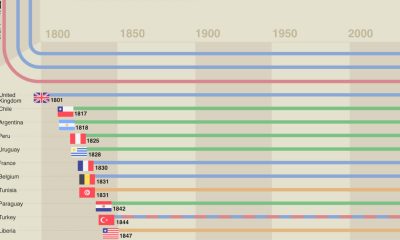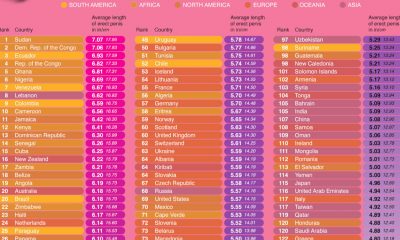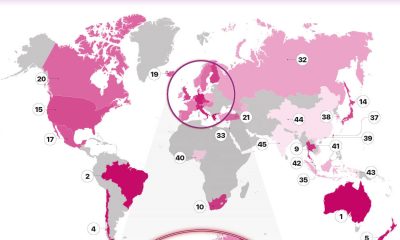Maps
How Does Every U.S. State Compare in Their Recess Policies?
If you are in your twenties or older, you probably look back to your elementary school days and remember recess fondly. Sadly, over the years some schools in the US have done away with recess entirely in order to boost test scores. Even though there are studies that contradict that very notion. In 2016, psychologist Karrie Godwin researched the attentiveness of elementary students during class and found they could focus better with lessons that were taught with short breaks. Recess and brain breaks not only help students decompress, but also encourages them to practice social skills and allows them to play creatively with their own imaginations. The students in the study were found to be more focused and less distracted when they were allowed short breaks. You may be surprised to find out that most states do not have any laws that require recess in schools. There are only five states that mandate a 20-minute break. This map of recess policies across America gives each state a grade letter score from A to F.
Click below to zoom
Massachusetts which is currently receives a D score has the opportunity to improve their grade if a recent bill is passed that requires 20 minutes of recess. There are some states like Maine, Maryland, Oregon, South Carolina, and Wisconsin where recess can be withheld from a student as a form of punishment. The best recess policies on the map are found in states that mandate 20-30 minutes of daily recess. Alaska, Arizona, Iowa, Arkansas, West Virginia, North Carolina, Virginia, New Jersey, and Rhode Island all got A’s.
Charts
A New Study Examines Infidelity in States Across America
NapLab looked at a sensitive topic for Americans everywhere by mapping survey results, which expose where people have engaged in and experienced the most infidelity. We can see from the results that cheating is, unfortunately, a very common experience, at least for the people who responded to the survey.
Click below to zoom.
The team’s data yields some surprising results. For example, 100% of respondents in North Carolina, Kentucky, and Alaska said they had cheated or been cheated on. Overall, in every state, over half the respondents said they have been cheated on. These are some hefty statistics.
Overall, these states ranked highest with residents most likely to cheat:
- Hawaii
- Louisiana
- Rhode Island
- Delaware
- Wyoming
- New Hampshire
- Maine
- North Carolina
- New Mexico
- Utah
These are the states where people are most likely to be cheated on:
- Kentucky
- Alaska
- Maryland
- North Carolina
- North Dakota
- Michigan
- West Virginia
- Oklahoma
- Maine
- South Carolina
Studies like this one can help us take steps to understand why infidelity occurs. Infidelity can be tricky to even define. Some may consider emotional involvement to be cheating, while others only consider physical romantic acts to be cheating. In other relationships, physical acts outside the relationship are acceptable as long as both partners are comfortable with them and the behavior stays within certain boundaries defined by the couple.
The data shows an interesting pattern, which is that more people reported being cheated on than cheating. This makes sense as cheating usually comes with a sense of shame. Not everyone admits to having cheated, but those who have been cheated on feel a sense of pain and outrage that makes them more likely to share their experience. Another interesting pattern is that the number of people who have self-reported that they cheated and have been cheated on is similar. That implies that many people have been both the cheater and the victim. How might that affect someone’s views on infidelity? The survey certainly leads to many more interesting questions.
People cheat for many varied reasons, including personal choices, social pressures, cultural norms, and dissatisfaction. Some couples say financial stress pushes them apart and builds resentment. The data may show some evidence for this, as low-income states like Kentucky and Louisiana rank highly on the list.
The team’s study leads to many more interesting questions to examine. For example, does age have anything to do with cheating rates? Studies seem to indicate it’s a yes. There have also been studies centered on gender, finding that men are more likely to cheat than women. Cultural factors are certainly impactful. A lot of research shows religious couples are less likely to cheat on one another, and the same is true in more conservative regions. This could be an inaccurate depiction, though, since stronger shame and taboos will make people more likely to carefully hide their infidelity and not admit to it. There’s no doubt that this study is a thought-provoking one.
Charts
Study Analyzes Kindergarten Measles Vaccination Gaps Across America
As of April 2025, there have been 16 measles outbreaks in the United States, a number that has jumped significantly over the past few years. A new study from PA Requirements shows this has a connection to vaccination gaps. Kindergarten vaccinations help protect citizens against diseases like measles and contribute to our population achieving herd immunity, which eradicates the threat of the disease. However, the team’s study reveals that a combination of policy, vaccine access, and community factors is hindering our progress toward this goal.
Click below to zoom.
The team found that these states had the highest percentage of children not vaccinated for measles:
- Idaho: 20.4%
- Alaska: 15.7%
- Wisconsin: 15.2%
- Minnesota: 13.0%
- Florida: 11.9%
- Oklahoma: 11.7%
- Colorado: 11.7%
- Utah: 11.2%
- Iowa: 10.9%
- Ohio: 10.8%
It can be useful to compare these numbers to the states with the lowest rates of unvaccinated children:
- West Virginia: 1.7%
- New York: 2.3%
- Connecticut: 2.3%
- Mississippi: 2.5%
- Maine: 2.5%
- Rhode Island: 2.9%
- Maryland: 3.4%
- Massachusetts: 3.7%
- California: 3.8%
We can observe some interesting regional patterns by examining the map, such as lower vaccination rates in the Midwest and Southwest.
Among the states with high rates of vaccination, we find that these five states don’t allow non-medical vaccination exemptions: Maine, New York, West Virginia, Connecticut, and California. It’s no surprise that stricter policies lead to a greater number of vaccinations. Among states with lower rates, we find more relaxed laws that allow for greater exemptions on the basis of religion, philosophy, and other personal reasons. Comparing each state to its neighbors reveals patterns and trends that might imply cultural differences affecting vaccination rates in different regions. We can look for locations with a high prevalence of religions that outlaw vaccines to identify reasons for the numbers on the map. Check the numbers on the states with the largest cities, and you might find stricter vaccination laws there to help prevent disease spread in population-dense areas.
There’s no doubt that state policies correlate directly with vaccination rates when we look at the numbers presented on the team’s graphic. Many states require certain vaccinations, like measles, in order to enroll in public school. These laws and requirements also directly impact vaccination rates. Looking at insurance costs and access to vaccine clinics in rural areas may also reveal why some areas have more unvaccinated children than others. Some states have created initiatives to encourage vaccination and provide education, leading to higher vaccination rates.
Overall, studies like these greatly benefit public health by increasing awareness and education about diseases like measles. People who shy away from vaccines often find them untrustworthy. The only way to convince them otherwise is to answer their questions and present them with transparent data that’s easy to understand, just like the information shown in this graphic, regarding the risks associated with declining vaccines. These studies provide policymakers, parents, and public health officials with more information to make informed decisions for the health of their children and communities.
Charts
Study Examines the Best and Worst States for Mothers to Live
A new study from Kremp examines an important aspect of motherhood. They created a scoring system to determine the best and worst locations for mothers to live in. Thanks to the multitude of details the team provided, we can see exactly how they came to their conclusions. The criteria for the scoring system examine diverse ways a community can support mothers and analyze the health and well-being of mothers and children living in each state. While something like a motherhood experience is subjective, these criteria give a fair way to compare motherhood in various locations.
Click below to zoom.
The methodology relied on these factors:
- Women’s Median Earnings
- Gender Wage Gap
- Child Care Costs
- Percentage of Mothers in Good or Excellent Health
- Percentage of Children in Good or Excellent Health
- Percentage of the Population Under 18
- State School System Scores
- Percentage of Parents Who “Definitely Agree” Their Child is Safe in School
- Weeks of Parental Leave Available
- Paid Family Leave Availability
- Job Protection
Based on these criteria, these ten states scored the highest:
- Massachusetts
- Maryland
- Connecticut
- Kentucky
- Delaware
- South Dakota
- New York
- Rhode Island
- Florida
While these ten states received the lowest scores:
- Montana
- Arizona
- Hawaii
- Idaho
- South Carolina
- Oklahoma
- Louisiana
- Michigan
- Nevada
- West Virginia
- New Mexico
The study and map are helpful precisely because motherhood is such a subjective experience. One mother may consider education of the utmost importance, while another may not be so concerned with this but focused on childcare costs and healthcare. While the study aimed to take all these factors together and score them as a whole, concerned moms can use this data to draw their own conclusions and judge the best location for their family’s needs.
The “best” state for moms often depends on the type of mother. A working mom might have vastly different priorities from a stay-at-home mom. A working mom would likely agree that Massachusetts is the best state for them because of a smaller wage gap and plenty of paid parental leave. In fact, Massachusetts offers the most parental leave compared to all other states. A mom of one child will have unique needs compared to a mom with four children. The age of the children also plays a role. Do the children need daycare, or are they all school-aged? A single Mom may consider Virginia the best state for their situation because of the low cost of living compared to average wages, though once again, Massachusetts has a lot to offer.
The map aspect of the study’s design gives us interesting insights, too. The color patterns show us that many of the best states for motherhood are in the Northeast, while many of the worst states are in the South. This map certainly gives parents something to think about if they are considering a move or planning a future family.
-

 Business Visualizations9 months ago
Business Visualizations9 months agoEverything Owned by Apple
-

 Business Visualizations8 months ago
Business Visualizations8 months agoAmerica’s Most Valuable Companies Ranked by Profit per Employee
-

 Business Visualizations2 months ago
Business Visualizations2 months agoThe Biggest Employers by Industry
-

 Business Visualizations4 months ago
Business Visualizations4 months agoThe Biggest Fortune 500 Company in Every State
-

 Timelines1 year ago
Timelines1 year agoA History of the Oldest Flags in the World
-

 Maps1 year ago
Maps1 year agoPenis Lengths Around the World
-

 Business Visualizations2 years ago
Business Visualizations2 years agoHow Many Companies Does Elon Musk Own?
-

 Charts2 years ago
Charts2 years agoThe Most Promiscuous Countries in the World




